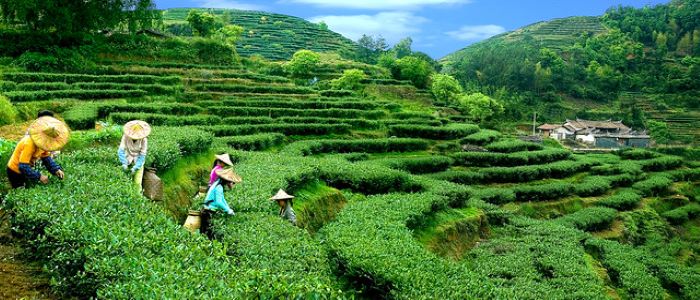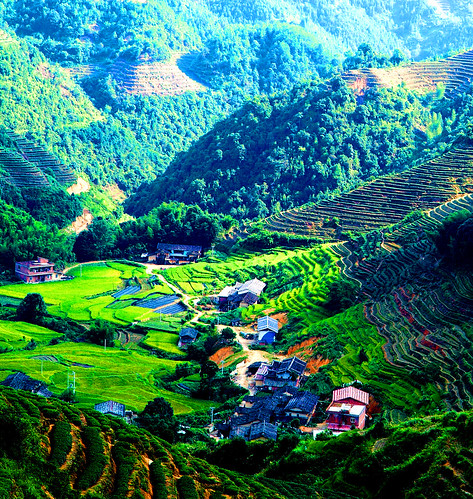中文 |

Anxi Tieguanyin Tea Culture System
Source: www.fao.org/giahs | 2022-06-08 17:28 Click:

Thanks to the unique physical geographic environment, Anxi has a long history of tea trees cultivation and tea making process. Indeed, Anxi has more than 1,000 years’ history of tea planting including the discovery of Tieguanyin plant 300 years ago and the creation of Oolong tea making techniques. Anxi Tieguanyin belongs to Dark Green Tea (also known as Oolong Tea), and it is categorized as semi-fermented tea.
During the long course of tea planting and making, Anxi has formed a complex agricultural system that focuses on the variety breeding and cultivation of Tieguanyin, pest/disease control, eco-system management of tea gardens, tealeaves plucking and making process, and relevant culture, etc. The System also owns ecosystem functions, for example, conserving water and soil, retaining water sources, accelerating nutrient cycling, and adjusting microclimates, etc.
In the construction and management courses of Anxi Tieguanyin Tea Culture System, thanks to the implementation of Tea Trees—Forest—Green Manure compound cultivation method, the rational construction of water conservancy facilities and transportation facilities, an organic combination of trees, herbs, fertilizers, water, and road was realized. Therefore, Anxi is a unique example of tea garden model with stable terrace wall, orderly terraces, and good capability of water and soil conservation.

Global importance
As the place of origin of Oolong tea craftsmanship, and as the place where the variety of Tieguanyin tea tree was discovered, Anxi Tieguanyin Tea Culture System is of an evident global importance. Contributions made by Anxi people to the world’s tea industry, include the discovery of famous Tieguanyin, the invention of tea tree short scion cutting techniques, the creation and transmission of Oolong tea-making techniques.
Since Song Dynasty (960~1279 A.D.) and Yuan Dynasty (1206~1368 A.D.), Anxi tea culture has been spread to the world via the Maritime Silk Road. It belongs to and is the symbol of the Oolong Tea—one of the six major categories of Chinese Tea. As a type of semi-fermented tea, Tieguanyin Oolong falls in between the green tea and the black tea. Currently, there are more than 100 varieties of tea trees in Anxi, mainly varieties suitable for Oolong tea making. The richness of tea tree varieties is one of the uniqueness Anxi.
Around the thirteenth year of the Emperor Chongzhen’s reign (1640 A.D.), Anxi tea farmers were inspired by the fact that the tea tree branches buried accidentally could take root and sprout, therefore they created the Tea Tree Whole-plant Layering Propagation Method. Successively, other multiplication methods were experimented and improved such as the Tea Tree Long-scion Cutting Propagation Method and the Short-scion Cutting Propagation Method. These changes overcame various shortcomings of generative propagation methods that depend on seeds, and the disadvantages of vegetative propagation methods like layering.
Food and livelihood security
The most important products of “Anxi Tieguanyin Tea Culture System” are Tieguanyin fresh leaves and the finished tea made of fresh leaves. Over the past few years, Anxi County has actively promoted the development of extended industries of Tieguanyin tea industry with tea-related food products. In 2017, about 66.4% of Anxi population were receiving benefits from tea industry and it accounted for over 90 percent of total per capita income. In addition, the development of tea industry also drives the development of other relevant activities, such as food processing, e-commerce, machinery manufacturing, cultural tourism, and accommodation & catering, etc.
Planted around the Anxi Tieguanyin tea gardens, or intercropped between tea trees, crops (like maize and paddy), tubers (like potato and sweet potato), and oil-yielding crops (like soybean, peanut, and oilseed rape) are providing food and edible oil for locals. Meanwhile, straw and vine of these food crops can serve as not only fodder for livestock and poultry raised by local people, for example, hog, chicken, duck and goose, etc., but also as organic fertilizers under tea trees.
Agrobiodiversity
With a remarkable richness of tea tree varieties, Anxi County is well known as a prominent “treasure house of improved varieties of tea trees”. Currently, there are more than 100 varieties of tea tree, among which 81 local ones. Principal tea varieties in Anxi are Tieguanyin, Huangdan, Benshan, Maoxie, Meizhan and Daye Oolong. Tieguanyin, in particular, is the most representative one accounting for 64 percent of Anxi’s total area of tea gardens.
In addition, Anxi County has a rich agro-biodiversity that consists of crops, animals and microorganisms. In addition to tea trees, food crops, oil crops, vegetables, sugar-yielding crops, green manure crops, and fiber crops and fruit trees are grown. In addition, on Tea Mountains and in Anxi Tieguanyin tea gardens, dozens of edible fungi grow and livestock such as poultry are living. Lastly, freshwater aquatic products, like carp, grass carp, silver carp and white shrimp, are cultured in the ponds and around Anxi Tieguanyin tea gardens.
As a result, these green gardens form a stable ecosystem with strong regulation and control capabilities. Intercropping and relay-cropping approaches, such as tea-fruit symbiosis and tea-grass symbiosis, maintain rich habitat diversity within the tea gardens, turning them into important habitats for plants, animals and microorganisms. It comes along with a biodiversity network with stable structure and rich diversity that can better sustain and protect the biodiversity of the tea gardens.
Local and traditional knowledge systems
Anxi tea traditional knowledge mainly consists of tea trees cultivation, multiplication and tea leaves transformation. Tea cultivation starts with Tea Garden Site Selection and Construction.
Indeed, site selection of tea gardens has immediate impact on the quality and output capacity of Tieguanyin tea. Usually, tea gardens should be located in mountainous areas with specific soil conditions and water availability. Anxi tea farmers have created water drainage and conservancy systems. Flood control and water drainage system consists of isolated canals on upward side of tea gardens, and drainage ditches surrounding tea gardens. After garden land preparation, shelter forest and alley trees are planted on hilltop, in upwind inlet areas, or alongside roads. At the same time, tea gardens are divided, according to terrains and topography, into several plots surrounded by planted shelter forests.
Anxi County is the birthplace of tea tree vegetative propagation techniques in China. “Tea tree whole-branch layering propagation method” was first developed. Lately, tea farmers progressively created “Tea tree long-scion cutting propagation method”, based on “Tea tree whole-branch layering propagation method” and “Tea tree short-scion cuttage techniques”.
In Anxi, tea farmers have created, according to tea-making principles of completely-fermented black tea and non-fermented green tea, a complete set of process for “semi-fermented” Oolong Tea making. Taking factors like season, climate, variety, and maturity of fresh leaves into consideration, this process seeks to have the optimal quality of tealeaves. It consists of two processing stages: primary processing and refinement processing.
Culture, local values and social organizations
Anxi Tieguanyin tea culture has exerted significant influence on the evolution of the agricultural society in Anxi region, and further on the Fujian Business Culture, regional culture, religious belief, living custom, literature, and art. It has contributed to shaping cultural customs and the spirit of chadao (literally The Tao of Tea, or Tea-ism, referring to an artistic, ceremonial way of tea making, tea drinking, and relevant rituals) that are continuously evolving.
Tea Battle, also known as mingzhan, diǎncha, diǎnshi in ancient time, date back to late Tang Dynasty (618~907 AD). Emergence of Tea Battle implied that the custom of tea drinking was refined and purified artistically. In Anxi, with the development of Oolong tea and the creation of Tieguanyin Tea, tea farmers needed a way to communicate with, learn, and even compete with each other about tea-making techniques. Thereby, Tea Battle has gradually evolved into the form of tealeaves quality competition, a prototype of Anxi Tieguanyin Tea King Contest.
Landscapes features
Based on the climate type and the microclimate conditions in the mountain area, Anxi people plant hilltop head-water forests, construct villages and tea gardens on hillside, and reclaim farmland and build villages in the foothills. Combined with the rivers at the lowest altitude, a top-down spatial pattern of “Head-water Forests—Tea Gardens and Villages—Farmland and Villages—Rivers” has been formed through time. This spatial pattern provides both important landscape value and diversified ecological functions to the system.
Besides, during its time-honored history, Anxi people has formed landscapes related to tea culture with unique tea-making workshops and tea-culture-related ancient buildings. For example, Temple of Chachan (literally A Temple of Tea and Zen) in Xiping Town, and architecture landscape with old houses that have been closely related to tea trade, such as Rizhai (literally Village of the Sun) and Yuezhai (literally Village of the Moon). All these constitute a complete human landscape of tea culture and ancient buildings in a mountainous area.